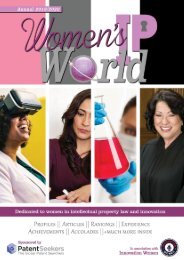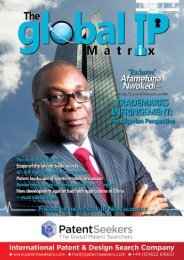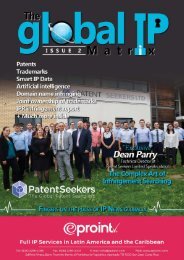Global IP Matrix - Issue 5
It has been a fantastic year for The Global IP Matrix magazine, thanks to all the efforts made by our contributors and to you, the reader for your continued support. We take great pleasure in putting together each issue of this publication, and we sincerely hope you enjoy this final issue of 2019. We have again, collaborated with some of the world's most influential IP law firms and businesses to bring you another eclectic mix of content, direct from the professionals working at ground level. We are already excited for the coming year and cannot wait to continue growing and evolving in our partnerships to bring you some exciting new features for 2020. Ms. Elvin Hassan Editor & Head of international liaisons
It has been a fantastic year for The Global IP Matrix magazine, thanks to all the efforts made by our contributors and to you, the reader for your continued support. We take great pleasure in putting together each issue of this publication, and we sincerely hope you enjoy this final issue of 2019. We have again, collaborated with some of the world's most influential IP law firms and businesses to bring you another eclectic mix of content, direct from the professionals working at ground level. We are already excited for the coming year and cannot wait to continue growing and evolving in our partnerships to bring you some exciting new features for 2020.
Ms. Elvin Hassan
Editor & Head of international liaisons
Create successful ePaper yourself
Turn your PDF publications into a flip-book with our unique Google optimized e-Paper software.
Second, the trademark agency shall be<br />
standardised, adding that “trademark agency<br />
shall not accept the entrustment if the<br />
trademark agency knows or should know that<br />
the entrusting party has engaged in malicious<br />
application” in paragraph 3 of article 19.<br />
At present, the majority of trademark<br />
agencies in the market are very professional.<br />
However, there are some bad agencies which<br />
assist in and are even directly engaged<br />
in malicious application and hoarding<br />
trademark applications. Some agencies set<br />
up affiliated companies in the field unrelated<br />
to the business which file a large number of<br />
trademark applications for sale. Some use their<br />
professional knowledge to maliciously file<br />
applications for the trademark of customers<br />
and also ask for high transfer fees. These have<br />
had an adverse impact on society. Under<br />
the new amendment, the trademark agency<br />
shall not accept entrustment for bad faith<br />
applications; otherwise, the trademark agency<br />
will be punished.<br />
Third, enhance the punishment against bad<br />
faith applications and bad faith litigations.<br />
Pursuant to paragraph 4 of article 68, those<br />
who apply for trademark applications in bad<br />
faith shall be given administrative penalties<br />
such as a warning or a fine according to the<br />
circumstances. Where a trademark lawsuit is<br />
brought in bad faith, the People’s Court shall<br />
punish it according to the law.<br />
As introduced, these kinds of bad faith<br />
applications will be directly rejected in the<br />
first pass of examination, but rejection is<br />
still far from enough because of the abuse of<br />
trademark rights. Bad faith litigation is not<br />
only detrimental to the alleged enterprises but<br />
also is a waste of judicial resources; moreover, it<br />
does not comply with the legislative purpose for<br />
trademark protection. Therefore, it is necessary<br />
to increase the provisions of punishment,<br />
which could give bad faith applications and<br />
bad faith litigations a real blow.<br />
Fourth, as a supporting measure for the<br />
revision of the trademark law, the CN<strong>IP</strong>A<br />
is studying and drafting a departmental<br />
regulation; “Regulation for Standardising the<br />
Trademark Application Behaviour,” which will<br />
operate a level of refinement. The content of<br />
the law to modify the specific behaviour of bad<br />
faith applications and hoarding trademarks<br />
and possible punishment measures. For<br />
instance, very obvious large numbers of<br />
trademark applications beyond a reasonable<br />
limit and repeated applications based on<br />
improper purpose will be listed.<br />
In addition to the possible rejection in<br />
examination, opposition, and invalidation,<br />
CN<strong>IP</strong>A also will use the credit record, industry<br />
self-discipline measures. Furthermore, if the<br />
circumstances are serious, the CN<strong>IP</strong>A could<br />
stop accepting applications represented by<br />
the trademark agency which violate the above<br />
provisions. At the same time, it stipulates<br />
that any organisation or individual that finds<br />
any abnormal trademark applications may<br />
provide clues to help the CN<strong>IP</strong>A to identify<br />
and punish the violator. The regulation is<br />
now closed for public comment and will be<br />
improved according to feedback, to implement<br />
the revised content of the new Trademark Law.<br />
Major change 2: strengthen<br />
the enforcement and raise<br />
possible damages for brand<br />
owners<br />
In recent years, China has been advocated<br />
to strengthen the protection of intellectual<br />
property rights and improve the system of<br />
punitive damages of intellectual property<br />
infringement. In judicial practice, such as<br />
the Beijing Intellectual Property Court, it has<br />
been gradually enhancing the damages for<br />
infringement of intellectual property rights.<br />
We have been able to see a few million and<br />
more than ten million worths of damages for<br />
patent cases. On the trademark side, it is rare<br />
to see more than a few million and<br />
even ten million worth of damage, which<br />
mostly ranges from more than tens of<br />
thousands to less than one million, which is far<br />
less than the profit of the infringing party.<br />
The low amount of damage for infringement<br />
has dramatically dampened the enthusiasm of<br />
intellectual property right owners. Therefore,<br />
a higher level for punitive damages needs<br />
to be introduced to substantially raise the<br />
cost of breaking the law and make infringers<br />
pay a heavy price. To further aggravate the<br />
infringement cost, infringers in bad faith<br />
should be punished, trademark rights should<br />
be strictly protected, and brand owners should<br />
be awarded adequate compensation. More<br />
specifically, for the statutory damage, it should<br />
be raised from 3 million to 5 million RMB. For<br />
willful infringement, it could be punitive and<br />
be raised once but not more than three times<br />
to the one time and not more than five times<br />
in total.<br />
www.gipmatrix.com<br />
The new Trademark Law also provides that, in<br />
the trial of a trademark infringement litigation,<br />
the People’s Court may, at the request of the<br />
rights holder, order the destruction of the<br />
commodities that bear a registered trademark<br />
which is owned by brand owners and the<br />
materials and tools that are mainly used to<br />
manufacture the counterfeits. Counterfeit<br />
goods may not enter into commercial channels<br />
after only removing trademarks. The above<br />
measures to take destruction and prohibition<br />
of access to commercial channels greatly<br />
increases the illegal cost of the counterfeiters<br />
and forms an effective deterrent to them. At<br />
the same time, the added provision makes<br />
the protection of trademark rights more<br />
comprehensive.<br />
Epilogue<br />
In recent years, Chinese President, Mr. Xi<br />
Jinping, officials and heads from all different<br />
levels of courts, the National Intellectual<br />
Property Administration and other<br />
departments have been implementing and<br />
emphasising the system of punitive damages<br />
for intellectual property to effectively curb<br />
<strong>IP</strong>Rs infringement.<br />
The overall trend of this amendment is mainly<br />
to strengthen the protection of intellectual<br />
property rights, hit bad faith trademark<br />
application behaviour without the real purpose<br />
of use, improve remedy systems against the<br />
bad faith applications and bad faith litigation,<br />
and increase the damages for the trademark<br />
infringement, especially willful trademark<br />
infringement in bad faith. Therefore, illegal<br />
cost will be significantly increased.<br />
It can be predicted that the cost of<br />
<strong>IP</strong>Rs infringement will be higher in<br />
the future. For those who violate <strong>IP</strong>Rs<br />
in bad faith, they may be punished<br />
until they lose all their money and<br />
have “nowhere to continue.” This<br />
is also good news for honest and<br />
trustworthy operators in China.<br />
Therefore, in conclusion, it will<br />
undoubtedly be more and more<br />
meaningful for operators to actively<br />
design and build their own intellectual<br />
property rights protection systems;<br />
so, they are timely and effectively<br />
detect infringements. They should<br />
also take vigorous rights protection<br />
actions where need be.<br />
19












